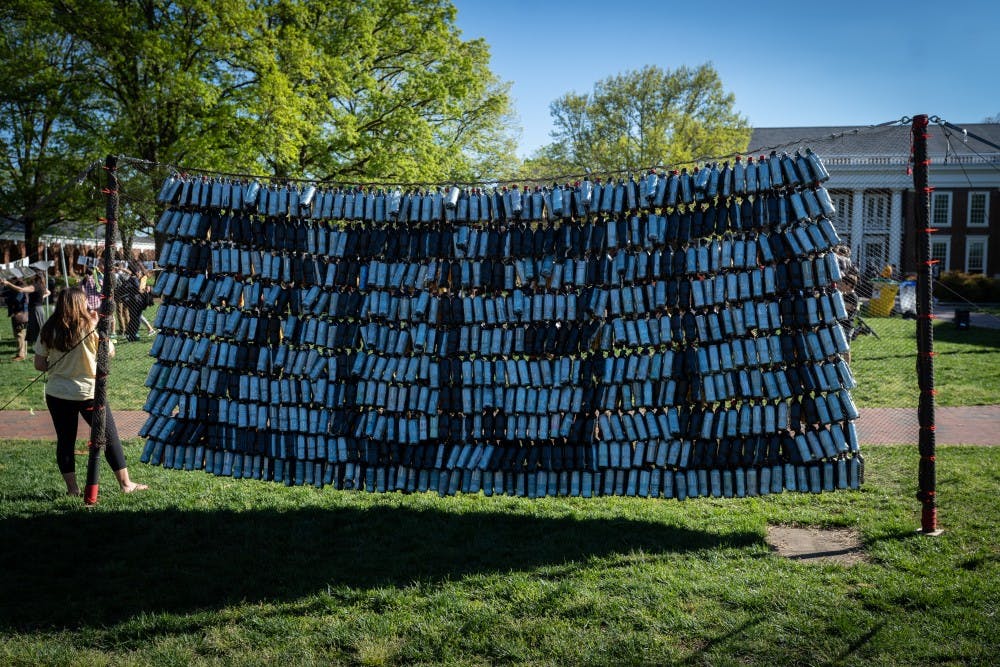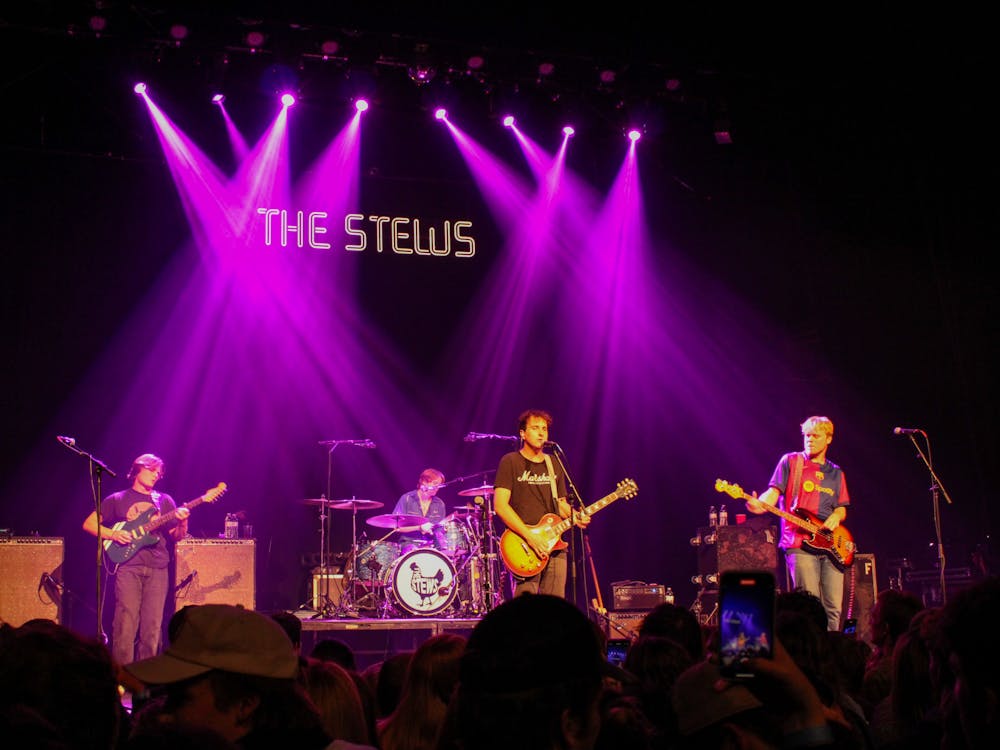Climate change has long been framed in national and local media as a political matter, with occasional surges of passionate interest that have never amounted to substantial legislative action. At the University, environmental science Prof. Deborah Lawrence and her students have been working to change that, using scientific evidence and activism through writing to spur green conversation and a sustainability mindset on Grounds.
It wasn’t until the professor read “The Constitution, By Hand,” a New York Times article by Morgan O’Hara, a Los Angeles-based conceptual artist who began collaboratively writing down the Constitution in the New York Public Library, that Lawrence realized the missing ingredient in climate activism — the power of demonstration and art.
“I found a different way to tell the climate story,” Lawrence said. Since then, Lawrence has been offering a Write Climate course at the University where students “scoured [scientific] papers for the words and the phrases and the paragraphs that meant something to them that really distilled the ideas.”
What surprised Lawrence was just how dedicated her students were, so much so that they wanted to be more involved after the class was over. “We created the club this semester because some of the things that the course did were sort of limited in scope,” said third-year College student Brian Hnat, Write Climate’s president. He says the club exists to help involved students engage in “more politically active things.”
“I was not terribly comfortable having the class do anything that was overtly political,” Lawrence said, mentioning her unease at bringing politics into the classroom. “There was a notion that we had unfinished work.” She said the club provided her students a more appropriate outlet for directly-involved activism.
Since its founding, the class and corresponding club have marketed themselves by painting Beta Bridge, attending a climate rally and writing letters to Congress advocating support for the Green New Deal, an ambitious Democratic resolution meant to provoke a climate conversation in American government.
Lawrence, her students and several performers and artists gathered outside Peabody Hall Monday to display a climate change installation constructed out of plastic bottles, a public art collaboration with Charlottesville artist Amanda Nelsen. Arts and Entertainment spoke with the professor, her students — who formed a club based off her class — and the artist responsible for the public piece to understand how these local groups came to this moment for Earth Day 2019.
For those skeptical of climate change, Lawrence also mentioned the benefit of tabling efforts her students did across Grounds. “Because we were out there randomly placed and not just talking to people who want to listen to us, I think we actually expanded the conversation to people who hadn't really thought about climate change very much.”
Lawrence’s students were eager to work on both an individual and broad level. Hnat mentioned “effecting change from an individual student level to trying to convince the [Ryan] administration to incorporate sustainability into their overall master plan.” A class grader and second-year College student Jasmyn Noel said the club activities were a “stepping stone for us to go above and beyond and make [sustainability] a culture throughout U.Va.”
Working with Charlottesville artist and teacher Amanda Nelsen was invaluable for giving the group’s idealistic message an artistic cohesion. “It's been good to have someone who shares the same vision as us,” Noel said. “[She] believes in what we're doing, and she actually helps us … with the artistic part.” The club’s secretary, second-year College student Satori Greene was also happy to work with Nelsen to combine scientific and artistic talent. “You don't see that crossover a lot,” Greene said. “I absolutely loved it.”
Arts and Entertainment interviewed Nelsen to get the artist’s perspective on the piece. Nelsen connected with Lawrence at a grant reception for the Write Climate project. “I used to be a high school art teacher,” said Nelsen. “I love teaching in a space where there are so many different perspectives so the students can come from a myriad of departments and majors.”
Nelsen said she gained inspiration for the piece when visiting the University’s recycling center, where materials are sorted manually by workers. “I just found that really kind of alarming, or you know, just really humbling,” she said. The experience inspired the piece to be made out of bottles. “I just had not known that that was a hand process and that those staff members actually were integral in our process because they were able to isolate the bottles that we needed.”
For Nelsen, the goal of the piece is to attract attention. In it, plastic bottles are arranged, yellow dyed on one side and blue on the other. On the yellow side contrasting black bottles read “Unless”, and on the blue side “2030”.
“I want it to be … a visual reminder of the importance and urgency of addressing climate change,” Nelsen said. Within each bottle is a piece of paper from responses the club gathered while tabling. “It's just an incredible experience I think that's all wrapped up in each one of those bottles,” Lawrence said. “The bottles of course come together — almost 1,300 bottles to make a bigger whole.”
Nelsen wanted the work to alarm, but not be overly pessimistic — a sentiment she emphasized when speaking Monday.
“What I hope is that this work is striking enough and provocative enough in some ways but also uplifting enough,” she said. “Because it needs to be something that we collectively believe as is possible and that we can commit to working towards.”
While the words were revealed on Monday, the club displayed the installation in a preview capacity since the previous Wednesday night.
“Just having our project already out there like, sparks that curiosity and conversation which we're trying to do through art in the first place,” said Greene. Noel added the significance of the timing. “During Days on the Lawn … a lot of parents, future students were coming up saying ‘Oh, what's this?’” Noel said.
Having the work be so public is something Nelsen, Lawrence and the students all hope will help rewrite the perception that the University is not a leader in sustainability. “Changing that culture would be the greatest reward that we could get from something like this,” Hnat said.
All shared similar sentiments when discussing the future of the installation . “We only have a permit for a week,” Lawrence said. “We are looking for a second home for that piece.” Lawrence hopes that could be somewhere where it is seen and talked about, like Route 250. “5,000 vehicles drive on 250 every day,” she said. “I would love to get our piece installed somewhere where lots of people would see it.”
Nelsen foresees the piece having a long life of travel. “It could move around Grounds, it could move around the city, it could move into different cities,” Nelsen said. Lawrence’s students would ultimately like to see the work’s influence spread as well. “The goal was to spread this around to other schools,” said Hnat. “To have other schools follow in our lead in a project like this.”
Write Climate’s installation will be on display outside of Peabody Hall through Friday.





